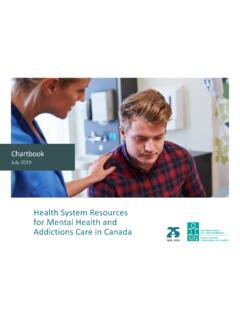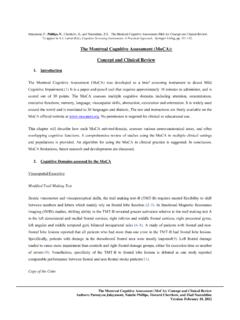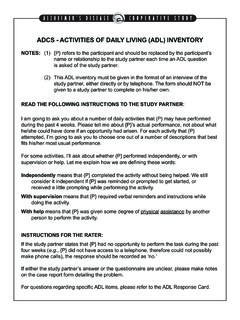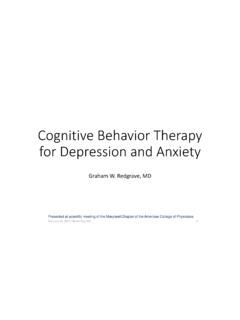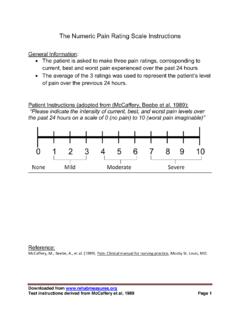Transcription of Describing Outcome Scales (RAI-MDS 2.0)
1 Outcome Scales Descript ion RAI-MDS Assessment Items Score Range Describing Outcome Scales (RAI-MDS ) Outcome Scales Description RAI-MDS Assessment Items Score Range DRS Depression Rating Scale This scale can be used as a clinical screen for depression. Validated against the Hamilton Depression Rating Scale (HDRS), the Cornell Scale for Depression in Dementia (CSDD) and the Calgary Depression Scale (CDS). Seven Depression Rating Scale items Negative Statements (E1a) Persistent Anger (E1d) Expression of Unrealistic Fears (E1f) Repetitive Health Complaints (E1h) Repetitive Anxious Complaints (E1i) Sad, Pained, Worried Facial Expression (E1l) Crying, Tearfulness (E1m) 0 14 A score of 3 or more may indicate a potential or actual problem with depression.
2 CHESS Changes in Health, End-Stage Disease and Signs and Symptoms This scale detects frailty and health instability and was designed to identify residents at risk of serious decline. Nine CHESS items Decline in Cognition (B6) Decline in ADL (G9) Dehydration (J1c) Edema (J1g) Shortness of Breath (J1l) Vomiting (J1o) End-Stage Disease (J5c) Weight Loss (K3a) Leaving Food Uneaten (K4c) 0 5 Higher scores indicate higher levels of medical complexity and are associated with adverse outcomes, such as mortality, hospitalization, pain, caregiver stress and poor self-rated health. Pain Scale This scale summarizes the presence and intensity of pain.
3 This scale validates well against the Visual Analogue Scale. Two Pain Scale items Frequency of Pain (J2a) Intensity of Pain (J2b) 0 3 Higher scores indicate a more severe pain experience. ADL* * Activities of Daily Living Self-Performance Hierarchy Scale This scale reflects the disablement process by grouping ADL performance levels into discrete stages of loss (that is early loss: personal hygiene; middle loss: toileting and locomotion; late loss: eating). Four ADL Self-Performance Hierarchy Scale items Personal Hygiene (G1jA) Toilet Use (G1iA) Locomotion (G1eA) Eating (G1hA) 0 6 Higher scores indicate greater decline (progressive loss) in ADL performance.
4 ADL Short Form This scale provides a measure of the resident s ADL self-performance status based on items that reflect stages of loss (early, middle and late loss). Four ADL Short Form items Personal Hygiene (G1jA) Toilet Use (G1iA) Locomotion (G1eA) Eating (G1hA) 0 16 Higher scores indicate more impairment of self-sufficiency in ADL performance. ADL Long Form This scale provides a measure of the resident s ability to perform ADLs. The ADL Long Form is more sensitive to clinical changes than the other ADL Scales . Seven ADL Long Form items Mobility in Bed (G1aA) Transfers (G1bA) Locomotion (G1eA) Dressing (G1gA) Eating (G1hA) Toilet Use (G1iA) Personal Hygiene (G1jA) 0 28 Higher scores indicate more impairment of self-sufficiency in ADL performance.
5 Page 2 Outcome Scales Description RAI-MDS Assessment Items Score Range ISE Index of Social Engagement This scale describes the resident s sense of initiative and social involvement within the facility. Six Index of Social Engagement items At Ease Interacting With Others (F1a) At Ease Doing Planned or Structured Activities (F1b) At Ease Doing Self-Initiated Activities (F1c) Establishes Own Goals (F1d) Pursues Involvement in the Life of the Facility (F1e) Accepts Invitations Into Most Group Activities (F1f) 0 6 Higher scores indicate a higher level of social engagement. Note: unlike other interRAI Scales , higher scores on the ISE are a good thing.
6 ABS Aggressive Behaviour Scale This scale provides a measure of aggressive behaviour. The ABS is highly correlated with the Cohen Mansfield Agitation Inventory (CMAI) Aggression Subscale. Four Aggressive Behaviour Scale items Verbally Abusive (E4b) Physically Abusive (E4c) Socially Inappropriate/Disruptive Behaviour (E4d) Resists Care (E4e) 0 12 Higher scores indicate higher levels of aggressive behaviour. interRAI PURS Pressure Ulcer Risk Scale This scale differentiates risk for developing pressure ulcers. Seven interRAI Pressure Ulcer Risk Scale items Bed Mobility Self-Performance (G1aA) Walk in Room Self-Performance (G1cA) Bowel Incontinence (H1a) Shortness of Breath (J1l) Daily Pain (J2a) Weight Loss (K3) History of Resolved Ulcer (M3); or Pressure Ulcer (M2a) for quarterly assessment 0 8 Higher scores indicate a higher relative risk for developing a pressure ulcer.
7 CPS cognitive Performance Scale This scale describes the cognitive status of a resident. Validated against the Mini-Mental State Examination (MMSE) and the Test for Severe impairment (TSI) The chart illustrates how the RAI-MDS CPS scores relate to the MMSE scores. CPS Score Description MMSE Equivalent Average 0 Intact 25 1 Borderline Intact 22 2 mild impairment 19 3 Moderate impairment 15 4 Moderate/Severe impairment 7 5 Severe impairment 5 6 Very Severe impairment 1 Five cognitive Performance Scale items Comatose (B1) Short-Term Memory (B2a) Cognition Skills for Daily Decision-Making (B4) Expressive Communication (C4) Eating (G1hA) 0 6 Higher scores indicate more severe cognitive impairment .
8 CIHI 2013 RAI-MDS interRAI Corporation, Washington, , 1995, 1997, 1999. Modified with permission for Canadian use under licence to the Canadian Institute for Health Information.

